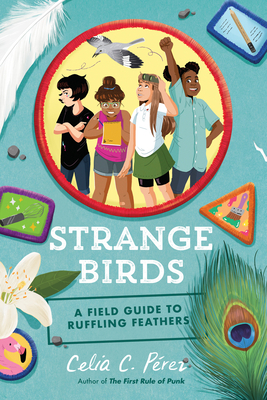Review by Cris Rhodes
 DESCRIPTION OF THE BOOK: When three very different girls find a mysterious invitation to a lavish mansion, the promise of adventure and mischief is too intriguing to pass up.
DESCRIPTION OF THE BOOK: When three very different girls find a mysterious invitation to a lavish mansion, the promise of adventure and mischief is too intriguing to pass up.
Ofelia Castillo (a budding journalist), Aster Douglas (a bookish foodie), and Cat Garcia (a rule-abiding birdwatcher) meet the kid behind the invite, Lane DiSanti, and it isn’t love at first sight. But they soon bond over a shared mission to get the Floras, their local Scouts, to ditch an outdated tradition. In their quest for justice, independence, and an unforgettable summer, the girls form their own troop and find something they didn’t know they needed: sisterhood.
MY TWO CENTS: The stakes of activism are not the same for all who engage. Skin color, gender presentation, age—all of these are contributing factors to who is most at-risk when being a visible activist. But, as Celia C. Pérez’s sophomore novel, Strange Birds: A Field Guide to Ruffling Feathers, rightly notes, “’[s]ometimes the desire for change is bigger than anything else’” (270). For Ofelia, Aster, Cat, and Lane—the desire to change the outdated traditions of the scout troop, the Floras, is bigger than the risks they encounter. Spurred by Cat’s passion for birds, the girls decide to campaign to change the Floras’s most cherished symbol: the feathered hat worn by the winner of the Miss Floras contest. The hat, however, is a relic of a past that nearly caused the extinction of multiple bird species across the United States.
 While the Migratory Bird Treaty Act of 1918 outlawed the practices that lead to the creation of hats like those worn by the winner of the Miss Floras contest, it didn’t outlaw the hats that already existed. The hat’s persistence in the lore of the Floras is problematic, but the hat represents different things for each girl. For Cat, the hat is the Floras’s suspension in the past; for Lane, the hat is an opportunity to rebel and make friends; for Ofelia, the hat is a chance to broaden her journalistic horizons; and for Aster, the hat parallels her desires to learn more about her own family history. Each girl’s storyline weaves together into a mission for change, even if the desired outcome (getting rid of the hat) stands in for something divergent for each.
While the Migratory Bird Treaty Act of 1918 outlawed the practices that lead to the creation of hats like those worn by the winner of the Miss Floras contest, it didn’t outlaw the hats that already existed. The hat’s persistence in the lore of the Floras is problematic, but the hat represents different things for each girl. For Cat, the hat is the Floras’s suspension in the past; for Lane, the hat is an opportunity to rebel and make friends; for Ofelia, the hat is a chance to broaden her journalistic horizons; and for Aster, the hat parallels her desires to learn more about her own family history. Each girl’s storyline weaves together into a mission for change, even if the desired outcome (getting rid of the hat) stands in for something divergent for each.
When I first started reading, I struggled a bit with remembering the distinction between each character, but I settled into the text quickly and was soon immersed in the community of Sabal Palms, Florida. On an aesthetic level, the text is upbeat, funny, and conversational. It makes the reader feel like they’re right beside Lane, Cat, Ofelia, and Aster as they plan their various (and often ill-fated) maneuvers against the Floras. The book also contains paratextual material corresponding to each character—like recipes from Aster or journalism tips from Ofelia. Like many recent books for young readers, Strange Birds is a good introduction to activism for young people who want to become more engaged in their worlds.
Further, in these unique, young characters, Pérez has created an ensemble cast that will resonate with a wide array of readers. Each girl is quite different—in fact, when Pérez revealed the cover of the novel on Nerdy Book Club, she included a personality quiz that lets readers see which girl they are most like (I’m an Ofelia, for the record, por supuesto).
Nevertheless, with a cast of characters like this, of young women from such different backgrounds, there is always tension. That Pérez doesn’t shy away from these moments is significant. Rather than sugarcoat their friendships and smooth over any dissonance, Pérez reveals the ways each girl wrestles with what could easily become asymmetrical relationships. Lane, the granddaughter of Sabal Palm’s most affluent family, has a distinct privilege among the other characters, not just because of her wealth but also because of her race. Often posed against Aster—the granddaughter of the first Black professor at Sabal Palms University and whose ancestors worked for Lane’s—Lane’s privileges are thrown into sharp contrast. When she must confront these privileges, all of the characters, including the Latinas Cat and Ofelia, take a look at their positionality within their community. In confronting how their social statuses are stratified by race and class, the girls grow closer because they acknowledge their differences. Resultantly, I view this as a strong text to introduce readers to the concept of intersectional feminism, a term coined by Kimberlé Crenshaw to explain that “because of [women of color’s] intersectional identity as both women and of color within discourses that are shaped to respond to one or the other, women of color are marginalized within both” (from “Mapping the Margins: Intersectionality, Identity Politics, and Violence against Women of Color” published in Stanford Law Review).
Ultimately, this is not a novel of single experiences. This is a novel that celebrates diversity. As with her debut middle-grade novel The First Rule of Punk, Pérez has invited readers to experience childhood as a time of transformation and self-actualization, a time of difference and discovery. Importantly, Strange Birds allows space for and encourages those discoveries to unfold, spread their wings, and take flight.
 ABOUT THE AUTHOR: Celia C. Pérez is the daughter of a Mexican mother and a Cuban father. Her debut book for young readers, The First Rule of Punk, was a 2018 Pura Belpré Award Honor Book, a 2018 Boston Globe-Horn Book Awards honor book, a winner of the 2018 Tomás Rivera Mexican American Children’s Book Award, a Junior Library Guild selection, and was included in several best of the year lists including the Amelia Bloomer List, NPR’s Best Books of 2017, the Chicago Public Library’s Best of the Best Books, the New York Public Library’s Best Books for Kids, School Library Journal’s Best of 2017, The Horn Book Magazine’s Fanfare, and ALSC’s Notable Children’s Books. Her second book for young readers, Strange Birds, will be published by Kokila, an imprint of Penguin Young Readers in September 2019.
ABOUT THE AUTHOR: Celia C. Pérez is the daughter of a Mexican mother and a Cuban father. Her debut book for young readers, The First Rule of Punk, was a 2018 Pura Belpré Award Honor Book, a 2018 Boston Globe-Horn Book Awards honor book, a winner of the 2018 Tomás Rivera Mexican American Children’s Book Award, a Junior Library Guild selection, and was included in several best of the year lists including the Amelia Bloomer List, NPR’s Best Books of 2017, the Chicago Public Library’s Best of the Best Books, the New York Public Library’s Best Books for Kids, School Library Journal’s Best of 2017, The Horn Book Magazine’s Fanfare, and ALSC’s Notable Children’s Books. Her second book for young readers, Strange Birds, will be published by Kokila, an imprint of Penguin Young Readers in September 2019.
She lives in Chicago with her family where, in addition to writing books about lovable weirdos and outsiders, she works as a librarian. She is originally from Miami, Florida, where roosters and peacocks really do wander the streets.
 ABOUT THE REVIEWER: Cris Rhodes is an assistant professor of English at Shippensburg University of Pennsylvania. She teaches courses of writing, culturally diverse literature, and ethnic literatures. In addition to teaching, Cris’s scholarship focuses on Latinx youth and their literature or related media. She also has a particular scholarly interest in activism and the ways that young Latinxs advocate for themselves and their communities.
ABOUT THE REVIEWER: Cris Rhodes is an assistant professor of English at Shippensburg University of Pennsylvania. She teaches courses of writing, culturally diverse literature, and ethnic literatures. In addition to teaching, Cris’s scholarship focuses on Latinx youth and their literature or related media. She also has a particular scholarly interest in activism and the ways that young Latinxs advocate for themselves and their communities.

Pingback: 2019 Titles By/For/About Latinx!! | Latinxs in Kid Lit